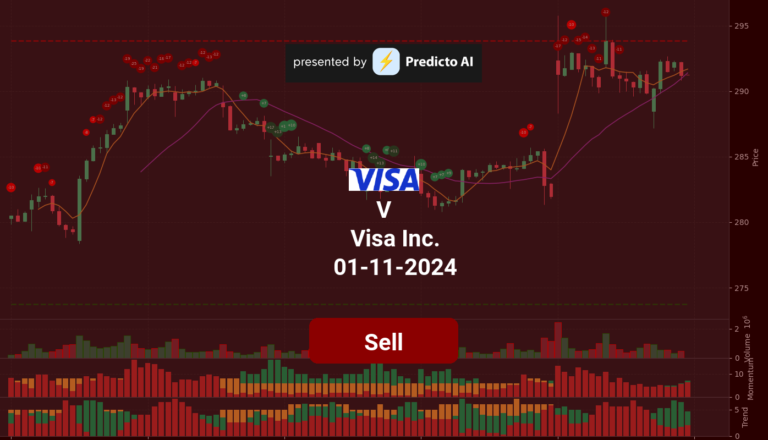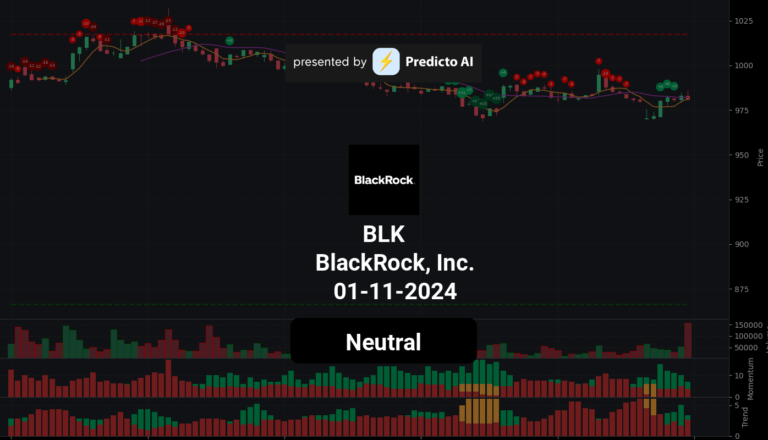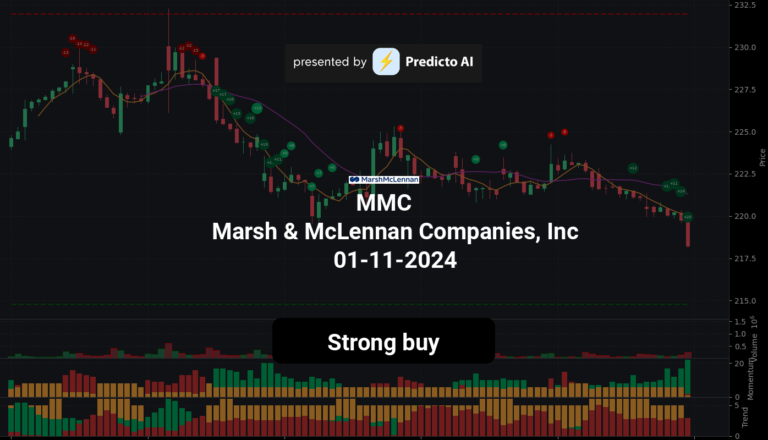PG Stock Analysis: A Mixed Bag of Signals!
🔴 Recommendation: Procter & Gamble Co. (PG) is currently rated a strong buy, but investors should tread carefully due to conflicting indicators that suggest both potential and risk.
📈 Key Highlights:
Momentum Indicators: Positive signs with a bullish crossover in StochRSI and a confirmed buy signal from WaveTrend, indicating possible upward movement.
Financial Health: Strong operating margin of 100.00% and a net profit margin of 15.28% reflect efficient operations and profitability.
Institutional Support: High institutional ownership at 69.23% suggests confidence from large investors.
⚠️ Caution Flags:
Declining Net Income: Recent net income of $3.14 billion shows a year-over-year decrease, raising concerns about future profitability.
Overvaluation Risks: A forward P/E ratio of 22.70 and a price-to-sales ratio of 4.72 indicate potential overvaluation relative to earnings.
Insider Activity: Recent insider selling totaling over $2 million could signal a lack of confidence from those closest to the company.
Let’s dive into the details as we break down the price trends, indicators, financial health, valuation metrics, and more 👇
PG Price Analysis

| Positive Momentum Signals | Negative Momentum Signals | Hold Momentum Signals |
|---|---|---|
|
|
| Positive Trend Signals | Negative Trend Signals | Hold Trend Signals |
|---|---|---|
|
|
|
Procter & Gamble Co. (PG) presents a complex investment landscape characterized by both positive and negative indicators. Currently, the stock is rated a strong buy, suggesting a favorable outlook based on recent momentum and trend analyses.
On the positive side, momentum indicators are showing encouraging signs. The StochRSI has indicated a bullish crossover, while the WaveTrendbuy signal with an oversold condition that may represent a potential bottom. These indicators suggest that the stock could be poised for upward movement in the near term.
Additionally, trend indicators are also leaning positive. The On-Balance Volume (OBV) is increasing, supported by high volume, which typically signals strong buying interest. Furthermore, the MACD has shown a positive histogram crossover, reinforcing the bullish sentiment.
However, caution is warranted due to several negative trend indicators. The stock price is currently below the Middle Band and is in a downtrend, indicating potential risks. It is also below the 50-day EMA and the 200-day EMA, both of which are indicative of a bearish trend that is strengthening. The Supertrend indicator also confirms a bearish trend, as the price remains below this level.
In summary, while Procter & Gamble Co. shows strong momentum and positive buying signals, the prevailing bearish trends and the stock’s position relative to key moving averages suggest that investors should proceed with caution. The current recommendation remains a strong buy, but investors should be aware of the underlying risks associated with the bearish indicators. Monitoring the stock closely for any changes in trend could be prudent as the market evolves.
PG Fundamental Analysis
PG’s recent financial performance presents a mixed picture, prompting a cautious outlook for potential investors. While the company showcases some strengths, several concerning trends cannot be overlooked.
The company’s **net income** for the most recent period stands at **$3.14 billion**, yet the year-over-year trend indicates a **decline**, raising questions about future profitability. On a positive note, PG boasts an **operating margin of 100.00%**, reflecting highly efficient operations and excellent cost control. Additionally, a **net profit margin of 15.28%** demonstrates a strong ability to generate profits after accounting for all expenses. However, the **negative net interest income of $113 million** suggests that PG is paying more in interest than it earns on its assets, which could strain financial resources. Furthermore, the **average net debt of $25.29 billion** warrants careful scrutiny regarding its impact on the company’s financial flexibility.
From a valuation perspective, PG faces challenges as well. The **forward P/E ratio of 22.70** implies that the stock may be overvalued relative to its earnings potential. Similarly, a **price-to-sales ratio of 4.72** indicates potential overvaluation, exceeding the typical threshold of 2. The **earnings growth of -7.10%** is particularly concerning, signaling a decline in profitability that could deter investors.
In terms of growth and profitability, PG reported **total revenue of $20.53 billion**, with a modest year-over-year growth of **1.67%**. However, a **revenue growth of -0.10%** suggests a slight decline, which could be a warning sign for future performance. While operating cash flow figures are not explicitly provided, the negative earnings growth raises concerns about the company’s ability to fund its operations effectively.
Shareholder information reveals an **average ordinary shares outstanding of 2.36 billion**, indicating a stable shareholder base. However, the **average treasury shares of 1.65 billion** could imply significant buyback activity, which raises questions about cash reserves and overall financial flexibility.
Examining the income statement, PG’s **net income of $3.14 billion** reflects profitability, despite the decline in year-over-year performance. The downward trend in revenue growth and net income could indicate potential challenges ahead.
On the balance sheet, the **debt-to-equity ratio of -2.20** suggests a moderate level of leverage, which may be manageable but requires careful monitoring. The **current ratio of 1.39** indicates a healthy liquidity position, suggesting that the company can comfortably cover its short-term liabilities. However, the **cash to total assets ratio of 0.07** points to limited financial flexibility and vulnerability to economic shocks. Additionally, the **average tangible book value is negative at -$15.47 billion**, raising concerns about the company’s financial position.
In terms of cash flow, PG’s **average capital expenditures of $3.08 billion** indicate that the company is investing in growth and expansion. The **positive net cash from financing of $28.66 billion** suggests that PG is raising capital, which could be utilized for growth initiatives or debt reduction. However, the **stock repurchases of $8.34 billion** could signal a positive outlook, yet they also raise concerns about the company’s cash reserves.
In summary, while PG demonstrates some positive indicators such as strong operating margins and moderate revenue growth, the concerns regarding declining net income, high debt levels, and potential overvaluation suggest a cautious approach. Investors should carefully evaluate these factors before making any investment decisions regarding PG stock.
Financial Health
🔴 Net Income for the most recent period was $3.14 billion, but the year-over-year net income trend shows a decrease, raising concerns about future profitability.
🟢 Operating Margin of 100.00% indicates highly efficient operations and excellent cost control.
🟢 Net Profit Margin of 15.28% reflects a strong ability to generate profits after all expenses.
🔴 Net Interest Income is negative at $113 million, suggesting the company is paying more in interest than it earns on its assets.
🔴 Average Net Debt of $25.29 billion warrants further investigation into its impact on financial flexibility.
Valuation
🔴 Forward P/E ratio of 22.70 suggests the stock may be overvalued relative to its earnings potential.
🔴 Price-to-Sales ratio of 4.72 indicates potential overvaluation, as it is above the typical threshold of 2.
🔴 Earnings Growth of -7.10% is concerning, indicating a decline in profitability.
Growth and Profitability
🟢 Total Revenue for the most recent period was $20.53 billion, with a year-over-year revenue growth of 1.67%, suggesting moderate growth.
🔴 Revenue Growth of -0.10% indicates a slight decline, which could be a warning sign for investors.
🔴 Operating Cash Flow is not explicitly provided, but the negative earnings growth raises concerns about funding operations.
Shareholder Information
🟢 Average Ordinary Shares Outstanding is 2.36 billion, indicating a stable shareholder base.
🔴 Average Treasury Shares of 1.65 billion could indicate significant buyback activity, but it also raises questions about cash reserves and financial flexibility.
Income Statement
🟢 Net Income of $3.14 billion shows profitability, despite the decline in year-over-year performance.
🔴 The decline in revenue growth and net income trend could indicate potential challenges ahead.
Balance Sheet
🔴 Debt-to-Equity Ratio of -2.20 suggests a moderate level of leverage, which may be sustainable but requires careful monitoring.
🟢 Current Ratio of 1.39 indicates a healthy liquidity position, suggesting the company can cover its short-term liabilities comfortably.
🔴 Cash to Total Assets Ratio of 0.07 indicates limited financial flexibility and vulnerability to economic shocks.
🔴 Average Tangible Book Value is negative at -$15.47 billion, indicating a concerning financial position.
Cashflow
🟢 Average Capital Expenditures of $3.08 billion suggest the company is investing in growth and expansion.
🟢 Positive Net Cash from Financing of $28.66 billion indicates the company is raising capital, which could be used for growth or debt reduction.
🔴 Stock Repurchases of $8.34 billion could be a positive signal, but they also raise concerns about cash reserves.
Overall, while there are some positive indicators such as strong operating margins and moderate revenue growth, the concerns regarding declining net income, high debt levels, and potential overvaluation suggest a cautious approach.
PG News Analysis
Procter & Gamble (PG) shows a generally positive outlook despite some mixed signals from insider trading and price target adjustments.
Summary of PG news indicates a favorable sentiment towards Procter & Gamble, with several analysts recommending it as a strong buy. However, insider selling raises some concerns. Overall, the stock appears to be a solid investment for the coming month.
🟢 Morgan Stanley has rated Procter & Gamble as an “Overweight” stock, suggesting it is a strong investment choice.
🟢 Billionaire investor Ray Dalio also views PG as a top stock to buy, indicating confidence in its long-term performance.
🔴 Goldman Sachs has slightly adjusted its price target for PG from $165 to $164 while maintaining a neutral rating, which may reflect some caution in the market.
🔴 Recent SEC filings reveal that insiders have sold shares worth significant amounts, totaling over $2 million, which could signal a lack of confidence from those closest to the company.
🟢 HSBC has raised its price target for PG from $178 to $186 while keeping a buy rating, reinforcing the positive outlook from other analysts.
PG Holders Analysis
The analysis of PG’s ownership structure and insider activity presents a mixed but generally positive outlook for the stock over the next month.
🟢 PG has a **high institutional ownership** at **69.23%**, indicating strong interest from large investors, which typically supports stock stability and growth. Major holders like Vanguard and Blackrock show confidence in the company’s long-term prospects.
🟡 The **very low insider ownership** at **0.05%** raises some concerns about management’s confidence in the company’s future. This could suggest a lack of alignment between management and shareholder interests.
🟡 Recent insider transactions show a **mix of sales and purchases**, with a notable number of shares sold by insiders. While this could indicate a lack of confidence, it is essential to consider that these transactions may be part of pre-planned selling strategies.
🟢 The **number of institutional holders** at **4522** suggests a diversified ownership base, which can help mitigate volatility and provide stability to the stock price.
🔴 The **recent insider sales** could be interpreted as a negative signal, especially given the substantial volume of shares sold. This may create uncertainty among retail investors.
PG Analyst Ratings
The analyst ratings for PG show a mixed sentiment, with a notable number of hold ratings. In the past month, there have been 4 strong buy ratings, 15 buy ratings, and 10 hold ratings, indicating a cautious outlook among analysts. The recent downgrade from Barclays from Overweight to Equal-Weight adds a layer of concern. 🟡 The overall sentiment is neutral, with no strong sell ratings, but the presence of multiple hold ratings suggests that analysts are not overly optimistic about immediate growth.
🔴 Given the mixed ratings and the downgrade, it is likely that PG may experience limited movement in the next month, with potential fluctuations around its current price. The medium confidence level reflects the uncertainty in the market, suggesting that investors should be cautious before making significant moves.
PG Economic Analysis
Based on the US economic and market data:
🔴 The unemployment rate has increased to 4.3%, up from 4.1% in the previous month, indicating a potential slowdown in the labor market which could negatively impact consumer spending and, consequently, Procter & Gamble’s sales.
🟡 Retail sales have shown a slight increase, but the growth is modest at 3.1% compared to the previous month. This suggests that while there is some consumer demand, it may not be strong enough to significantly boost P&G’s revenue in the short term.
🔴 The CPI data indicates inflationary pressures remain, with the latest reading at 314.540. This could lead to increased costs for P&G, impacting profit margins if they are unable to pass these costs onto consumers.
🟢 Despite these challenges, P&G’s strong brand portfolio and consistent dividend yield of 2.38% may provide some stability for investors looking for defensive plays in a volatile market.
🔴 The overall economic indicators suggest a cautious outlook for the next month, with potential headwinds from rising unemployment and inflation impacting consumer behavior.
In summary, while P&G has a solid foundation, the current economic environment presents challenges that may limit price appreciation in the near term. The stock is likely to remain stable but may not see significant upward movement.
Disclaimer
Investors may consider the AI predictions and news summaries as one factor in their investment decisions alongside their own research and risk tolerance.




